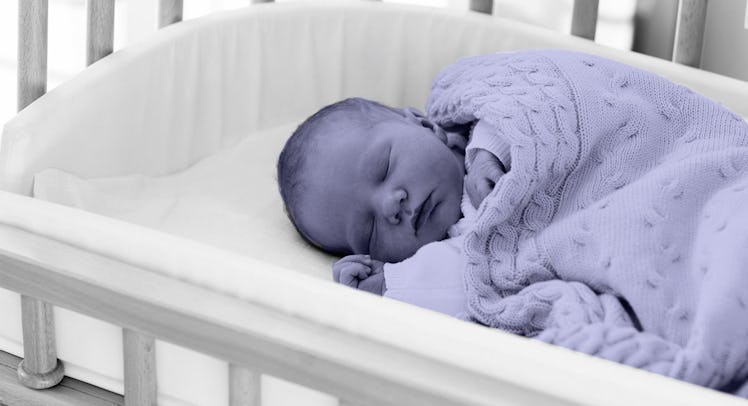5 Unsafe Sleep Products That Parents Keep Using
We’ve collected a short list of some of the most dangerous sleep products — from bumpers to blankets — that parents should never ever buy.

In the United States, it’s estimated that 6.5 out of every 1,000 children will not make it past the age of 5. While there are a number of different causes contributing to these deaths, many happen in what should be the most peaceful place in every home: the crib. It’s shocking just how many sleep products that have caused child fatalities are still available for purchase, online and even in stores, despite recalls and government warnings. We’ve collected a short list of some of the most dangerous sleep products — from bumpers to blankets — that parents should never ever buy.
READ MORE: The Fatherly Guide to Sleep
Crib Bumpers
Why You Shouldn’t Use It: Thick crib bumpers made of comforter material have been known to cause suffocation in children should they roll into it at a young age. The Food & Drug Administration (FDA) recommends against using bumpers in the crib — there were 27 reported deaths between 1985 and 2005 due to baby bumpers. Some states, like Ohio, have even banned the sale of certain bumpers because of their potentially fatal risks.
Potentially Dangerous Examples: Any of the thick, cutesy bumpers sold with crib bedding kits. You know the ones. Believe it or not, these are often still sold at big chain stores and online.
What to Use Instead: If you absolutely have to use a bumper, despite it still not being recommended, then using a breathable mesh version is the only option. Make sure it’s one with velcro and not ties, since those run a risk of entanglement and even strangulation.
Baby Registry Builder
A personalized registry for every type of parent. TAKE THE QUIZ
Sleep Positioners
Why You Shouldn’t Use It: Sleep positioners, sometimes called “bolsters” or “wedges,” are widely recommended against by the FDA and other organizations. While parents use them in an effort to prevent SIDS, they instead become a suffocation hazard themselves.
Potentially Dangerous Examples: Examples of the types of sleep positioners that have resulted in deaths can be found on the Consumer Product Safety Commission (CPSC) website.
What to Use Instead: Nothing. The National Institute of Child Health and Human Development (NICHHD) recommends an empty crib free of positioners, pillows, stuffed animals, or other items that might pose a suffocation hazard.
Crib Tents
Why You Shouldn’t Use It: Crib tents were created to prevent children from being injured from climbing out of their cribs, but the CPSC has recalled crib tents due to a fatality and another serious injuries resulting from the use of these hazardous products.
Potentially Dangerous Examples: The recall was specifically targeted at the Tots in Mind crib tent, but others are still on the market and just as dangerous. All crib tents should be avoided.
What to Use Instead: Basically if your child is old enough to be climbing completely out of their crib then it’s time to switch to a convertible crib they can get out easily, or a small bed.
Thick Blankets
Why You Shouldn’t Use It: While it might be tempting to pile on some blankets to keep your child warm at night, all you’re really doing is introducing a possible suffocation hazard into their crib. The AAP recommends not having any blankets whatsoever in the crib.
Potentially Dangerous Examples: The thicker the blanket, the more dangerous. So heavier blankets found in bedding kits are the worst offenders. This also applies to parents that co-sleep and have their bedding near their child.
What to Use Instead: If it’s cold then you should be dressing your child more warmly at night. Arm them with a long-sleeve onesie and fleece pajamas and they should be fine. You can turn up the heat a bit more if you’re worried, because a higher heating bill is a small price to pay.
Bedside Sleepers
Why You Shouldn’t Use It: Bedside sleepers are tempting for new parents that want to easily check on their baby and have them close for feedings in the middle of the night. However, there have been several recalls of these products due to fall hazards for the infant.
Potentially Dangerous Examples: The Arm’s Reach and Bednest bedside sleepers have both been subject to recalls due to the risk of infants falling. There have been no reported injuries in the United States, but the Arm’s Reach co-sleeper has had at least one reported fatality in Canada.
What to Use Instead: The recommended sleeping option by the AAP and CPSC is a traditional four sided crib. If it helps with your routine, move it into your bedroom and have it close, but don’t use a bedside sleeper.
Aside from being hazardous, all of the above sleep items have something else in common: their use comes from a good place. Parents want to prevent SIDS, make their child comfortable, or keep them warm. Sometimes, however, in the process of trying to care for a child, parents unintentionally introduce risk into their sleep environment. What’s worse is they often buy these products straight from stores that sell them as “safety” products.
The best way to make sure your child is safe in their crib is by consulting a safety guide from CPSC or other organizations every few months. The basic idea, though, is to keep objects such as positioners, pillows, stuffed animals, blankets, and other objects out of the crib, and never to use bumpers or tents around or on top of the crib. While many of these products should be removed entirely from shelves, for now it’s our job as parents to be aware of potential risks and to remove them.